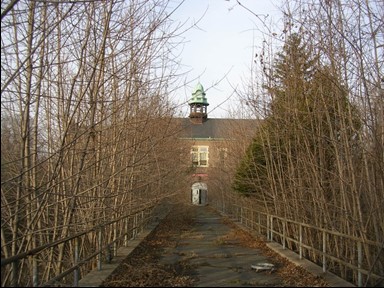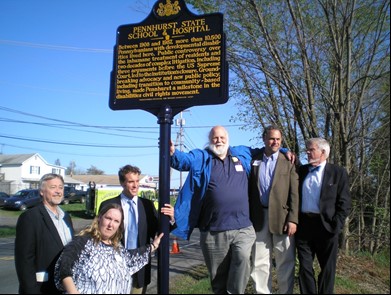Origins of the Pennhurst Memorial and Preservation Alliance
24 May 2022 – James W. Conroy and Katrina N. Jirik
Many countries have erected memorials to the state-sponsored suffering of their citizens, such as the Gedenkstaette memorial in Dachau, Germany and Freedom Park in Pretoria, South Africa. For more than 150 years, millions of Americans with developmental disabilities were segregated, isolated, neglected, and abused in overcrowded, state-funded institutions, as poignantly detailed in disability rights scholar Burton Blatt’s Christmas in Purgatory. The new book Pennhurst and the Struggle for Disability Rights details the importance of creating a memorial in remembrance of every American with disabilities who suffered at a state-sponsored institution. The work to establish this memorial is being undertaken by the Pennhurst Memorial & Preservation Alliance (PMPA) at the site of one such institution in Pennsylvania.
This is the first of four essays that highlights the advocacy and preservation work of the PMPA in creating this memorial. PMPA began in 2008 as an outgrowth of public historian Christian Cadwalader’s thorough historical documentation of Pennhurst, which opened in 1908 as the Eastern Pennsylvania Institution for the Feeble-Minded and Epileptic. Pennhurst rapidly became overcrowded and underfunded, and by the 1960s its conditions were inhumane. A class-action lawsuit, the first of its kind, resulted in a 1987 federal court order to close the institution. Pennhurst was typical of hundreds of other facilities across the country. By 1970 there were 293 institutions housing almost 200,000 people.
The Commonwealth of Pennsylvania failed to preserve Pennhurst after its closure, something preservationists regard as a gross violation of law and public responsibility. Pennsylvania law requires the Commonwealth to preserve and protect historic sites. Yet Pennhurst was allowed to crumble and become overgrown.

Pennhurst’s Administration Building, overgrown in 2006. Photo credit: James W. Conroy
Pennhurst’s status as a site of generational suffering and human horror justifies its preservation for future generations. In Germany, preserving the Dachau concentration camp as a memorial and educational site was deemed an important part of the country’s atonement process for the Holocaust. The memorial at Pennhurst serves a similar purpose; it preserves darker moments in disability history to remind and educate the public.
This memorial effort began at Pennhurst in 2008 when Cadwalader’s El Peecho website documenting the abandoned grounds caught the attention of a student of historic planning and preservation, Nathaniel Guest, who had a long fascination with the Pennhurst buildings. Cadwalader and Guest teamed with J. Gregory Pirmann–a 17-year Pennhurst employee, assistant superintendent, and unequaled source of historic and programmatic knowledge–as they began a serious effort to educate the public and preserve the grounds and its memory. Months later, the group recruited Janet Albert-Herman, an activist and parent; James W. Conroy, a researcher who studied Pennhurst and its closure; and Jean M. Searle, a member of the Pennhurst class action lawsuit. Together, they established the PMPA.
During the past 13 years, PMPA has worked to make Pennhurst indelible in the national and international awareness of the disability rights movement. In 2010 a Pennsylvania Historical Marker about Pennhurst and its important role in the disability rights movement was unveiled.

Pennhurst historic marker unveiling with PMPA board members James W. Conroy, Jean Marie Searle, Nathaniel Guest, J. Gregory Pirmann, Saul Rivkin, and attorney Tom Gilhool. Photo credit: PMPA
A documentary film about Pennhurst and preservation, A Call of Conscience, was completed in 2012. A public traveling exhibit was created that has been seen in more than 100 venues, including the Pennsylvania and U.S. capitols. In addition, PMPA board members produced two books, the previously mentioned Pennhurst and the Struggle for Disability Rights and Pennhurst State School and Hospital (Images of America).
The mission of the Pennhurst Memorial and Preservation Alliance is “to promote an understanding of the struggle for dignity and full civil rights for persons with disabilities, using the little-known history at Pennhurst. By sharing this tragic story as well as its landmark victories, we seek to educate citizens in local, national, and international communities, to assure that we never go back.” This history should be more broadly known.
In subsequent History@Work posts, three ongoing projects of the PMPA will be discussed in detail. Pennhurst is not the only institution in Pennsylvania with important local and national ties. Elwyn, an organizational ally of PMPA located near Philadelphia, was one of the first institutions for people with cognitive disabilities established in the United States. Its rich archival resources document not only the voices of superintendents, the most often investigated sources, but also the voices of parents, legislators, and others who have often not been given a voice. Their voices add nuance and greater understanding to the beginnings of services and supports for people with intellectual disabilities, the development and proliferation of the eugenically based institutional model, as well as the beginnings of the community movement. One post in this series will describe a successful partnership with Elwyn to reorganize its historic archives.
Another essay explores ongoing work with the present owners of the Pennhurst property to provide a physical space for public history outreach and a museum within the context of a current fright attraction. The Pennhurst site was purchased in 2008 by a company to be used as a haunted house, re-enacting some of the horror of institutionalization. Yet it also provides a community for disabled performers who feel accepted and welcomed there.
The history of disability has too long been a neglected part of American history–much like Latino, American Indian, and African American history. These histories are preserved in national museums, places not only to preserve history and culture but to provide education to the public. PMPA contends that it is time for the history and culture of people with disabilities to be accorded the same respect with the establishment of a national museum. The final post in this series discusses the potential development of a National Museum of Disability History and Rights.
This series of History@Work posts will address these important topics, bringing a greater understanding of the lives, culture, and history of Americans with disabilities.
~James W. Conroy is a board member and co-president of the PMPA. He is the co-author of Pennhurst and the Struggle for Disability Rights. He received his PhD in Medical Sociology from Temple University in 1992 and is the Principal Investigator and designer of the Pennhurst Longitudinal Study, the largest study ever done at that time on moving people with developmental disabilities from institutions to small community homes.
~Katrina N. Jirik received her PhD in the History of Science, Technology and Medicine in 2019 from the University of Minnesota. Her dissertation focused on bringing unheard voices into the history of American institutions for people considered “feeble-minded” at the turn of the twentieth century. She currently is a guest lecturer at several universities.



